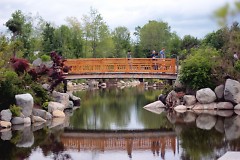Artfully placed boulders, precisely pruned plants and the sound of rushing water surround and fill an eight acre space at Frederik Meijer Gardens and Sculpture Park. After years of construction, the Richard and Helen DeVos Japanese Garden is ready to open this Saturday, June 13.
The Richard and Helen DeVos Japanese Garden, located in the middle of the 158-acre main campus of the Meijer Gardens, was designed by Hoichi Kurisu.
Kurisu was born in Hiroshima, Japan and is the president and founder of Kurisu International, Inc., which is headquartered in Portland, Oregon. He has been designing and building gardens for over 40 years.
The Japanese Garden is based on a centuries-old style and tradition, but also incorporates contemporary sculptures by international artists.
“It brings an incredible place of tranquility and beauty,” says President and CEO, David Hooker. “It’s another one of those gems that we get to have in West Michigan.”
The $22 million Japanese Garden is funded by donations made by Fred and Lena Meijer, and Richard and Helen DeVos, as well as donations by numerous community members.
In 2009, Fred Meijer asked Hooker about the possibility of adding a Japanese garden to the space. Construction began in 2012 to fulfill one of Meijer’s last requests for the gardens.
“Fred said David, I think we ought to have a Japanese Garden, what do you think? And now here we are,” Hooker says.
According to Hooker, Meijer also asked that a teahouse be included, because “Lena loved to have tea with her friends.”
An authentic Japanese Teahouse is one if the main features of the garden and can be seen from every viewing spot in the Japanese Garden. According to the Meijer Gardens website, the teahouse was first constructed in Japan, dismantled, then shipped and reassembled at the Meijer Gardens. Traditional Japanese tea ceremonies will be available by appointment.
Other features within the Japanese Garden include a Zen-style Garden, a bonsai garden, multiple bridges, viewing islands, gazebos, various contemporary sculptures and four waterfalls.
The three main elements in a Japanese Garden are rocks, water and plants. The plants provide an aesthetic change as the garden ages and the seasons change. The importance of seasons is emphasized in Japanese culture.
“We do a lot for seasons already [at Meijer Gardens],” LaWarre says. “What we're going to be able to do with [all four] seasons, that’s yet to be known.”
Hooker clarified that the plants in the garden need not be native to Japan. He says a Japanese Garden is not a collection of Japanese plants and that Hoichi, as the artist, has used a palette of plants and rocks that work well in West Michigan.
“The Japanese garden is an artform, not a recipe,” he says.
It’s the aesthetic and way its been put together by Hoichi, Hooker says, that is what makes it an authentic Japanese garden.
While some of the plants in the garden are natively Japanese and some native to Michigan as well as other temperate climates, all of the plants came from nurseries within the United States.
“It was such an experience to work with someone of that caliber,” says Lead of Horticulture Greg Afman, who worked closely with Kurisu during the construction process. Afman says he learned a lot from Kurisu.
“If only I had 20 more years to work with him,” he says.
Steve LaWarre, director of horticulture at Meijer Gardens, says that while normally with a project of this size, the designer would start with a blank slate, with the Japanese Garden “they preserved as much of the natural feel as possible.”
The Rapidian, a program of the 501(c)3 nonprofit Community Media Center, relies on the community’s support to help cover the cost of training reporters and publishing content.
We need your help.
If each of our readers and content creators who values this community platform help support its creation and maintenance, The Rapidian can continue to educate and facilitate a conversation around issues for years to come.
Please support The Rapidian and make a contribution today.
